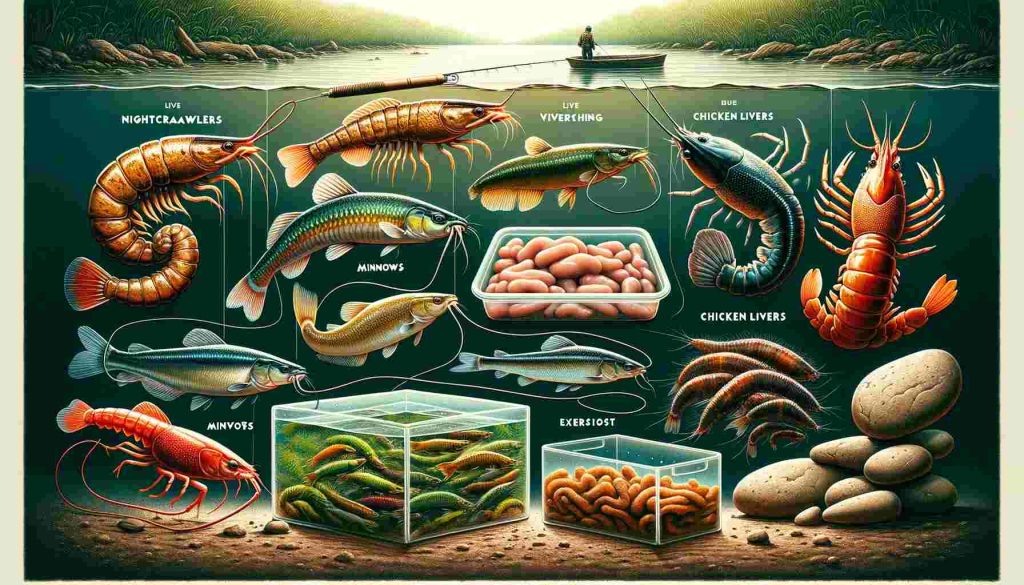Fishing for catfish can be both exciting and rewarding, but to increase your chances of success, choosing the right bait is essential. Catfish are known to be opportunistic feeders, and their preferences can vary depending on factors such as species, location, and environmental conditions.
In this comprehensive guide, we’ll explore the best fishing baits for catfish, including natural options, prepared baits, and DIY recipes, to help you reel in your next big catch.
Understanding Catfish Feeding Behavior
Before delving into the specifics of catfish bait, it’s important to understand the feeding behavior of these freshwater giants. Catfish are bottom-dwelling fish with a highly developed sense of smell and taste. They are scavengers by nature, often feeding on a wide range of prey, including insects, crustaceans, smaller fish, and organic matter. This scavenging behavior makes them receptive to a variety of bait types, both natural and artificial.

Natural Baits for Catfish
- Nightcrawlers (Earthworms): Catfish have a strong affinity for nightcrawlers, which are readily available and easy to use. Nightcrawlers can be found in moist soil, particularly after rain, or purchased from tackle shops. Their natural scent and movement make them irresistible to catfish, making them a go-to bait for many anglers.
- Chicken Livers: Chicken livers are another highly effective bait for catfish, appreciated for their strong odor and soft texture. Simply hook a piece of chicken liver onto your fishing line, and you’re ready to go. Many anglers swear by chicken livers for attracting larger catfish, especially in rivers and lakes with a healthy catfish population.
- Shad: Shad, particularly gizzard shad, are natural prey for catfish in many freshwater environments. Anglers can use live or cut shad as bait, with the latter being particularly effective for larger catfish. They can catch shad using cast nets or purchase them from bait shops.
- Minnows: Small fish such as minnows can also be effective bait for catfish, especially when targeting smaller species or juvenile catfish. Hooking a live minnow or using cut bait can entice catfish to strike, particularly in rivers and streams where minnows are abundant.
- Crayfish: Crayfish, also known as crawdads or crawfish, are a natural prey item for catfish, especially in areas where both species coexist. Using live or freshly killed crayfish as bait can be highly effective, particularly for larger catfish species that prey on crustaceans.
Are worms the best fishing bait? Find out here!
Prepared Baits for Catfish
In addition to natural baits, many anglers rely on commercially prepared baits to attract catfish. Manufacturers design these baits to mimic the scent and texture of natural prey, often enhancing them with additional attractants to lure catfish.
- Stinkbait: Stinkbaits are a type of prepared bait known for their strong odor, which is highly attractive to catfish. These baits typically consist of a doughy mixture infused with potent scents such as cheese, blood, or shrimp. Stinkbaits are commonly used in dough or dip form, making them easy to apply to hooks or bait holders.
- Punchbait: Punchbait is another popular choice among catfish anglers, known for its sticky consistency and potent scent. This type of bait is designed to be punched onto a treble hook using a specialized baiting tool. Once applied, punchbait forms a potent scent trail in the water, attracting catfish from a distance.
- Prepared Dough Baits: Prepared dough baits, such as Berkley PowerBait Catfish Chunks or Little Stinker Catfish Tube Bait, are convenient options for anglers seeking an alternative to natural baits. These baits come in a variety of flavors and scents, allowing anglers to experiment with different options to find what works best in their local waters.

DIY Bait Recipes for Catfish
For anglers who prefer to create their own bait, countless DIY recipes exist that they can tailor to suit their individual preferences and fishing conditions. Here’s a simple recipe for homemade catfish bait using common kitchen ingredients:
Homemade Catfish Bait Recipe
Ingredients:
- 16 ounces of corn syrup
- 2-3 ounces of liquid flavoring (e.g., strawberry extract)
- Oats
- Sweet feed
Instructions:
- In a mixing bowl, combine the corn syrup and liquid flavoring, stirring until well blended.
- Gradually add oats and sweet feed to the mixture, stirring until the desired consistency is reached. The bait should be thick enough to hold together on a hook but soft enough to release scent into the water.
- After mixing the bait, form it into balls or nuggets and place them in a sealed container for transport to the fishing site.
Tips for Using Catfish Bait Effectively
Regardless of the type of bait you choose, there are several tips to keep in mind to maximize your chances of success when fishing for catfish:
- Match the Bait to the Environment: Consider the habitat and feeding preferences of the catfish in your chosen fishing location. For example, if fishing in a river with abundant crayfish, using crayfish bait may yield better results than other options.
- Experiment with Scent and Flavor: Catfish rely heavily on their sense of smell to locate prey, so experimenting with different scents and flavors can help attract their attention. Be open to trying new bait options and adjusting your approach based on feedback from the fish.
- Use the Right Presentation: Pay attention to how you present your bait in the water. For bottom-dwelling catfish, a weighted rig that keeps the bait on or near the bottom may be most effective. In flowing water, consider using a slip sinker rig to keep your bait in the strike zone.
- Be Patient and Persistent: Catfish can be unpredictable in their feeding behavior, so patience is key when fishing for them. If you’re not getting bites right away, try adjusting your bait presentation or moving to a different location until you find success.
Conclusion
Selecting the best fishing bait for catfish requires a combination of knowledge, experimentation, and patience. Whether you prefer natural baits, prepared options, or homemade recipes, there are countless ways to attract catfish and reel in a memorable catch. By understanding the feeding behavior of catfish and tailoring your bait selection to the conditions at hand, you can increase your chances of success on your next fishing adventure.
So grab your gear, stock up on bait, and get ready to hook into some catfish action!
Here’s another great article that you should read: What Bait To Use For Bass: Unleash Your Skills With Expert Selection








